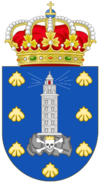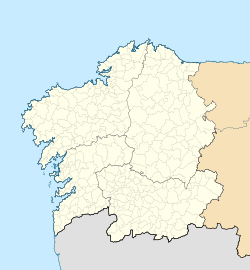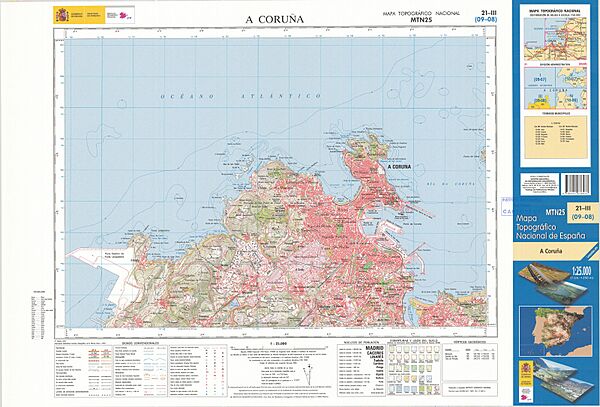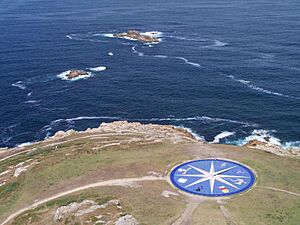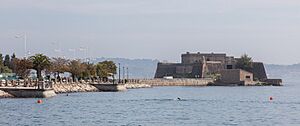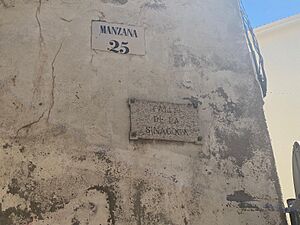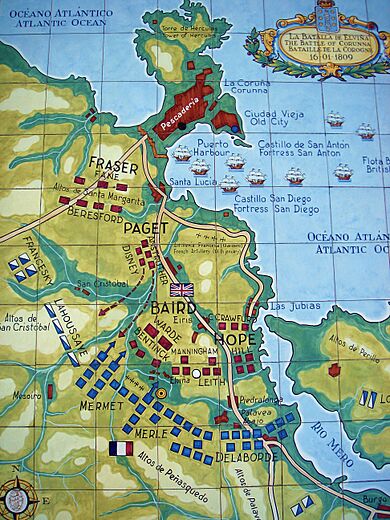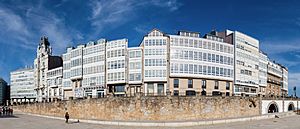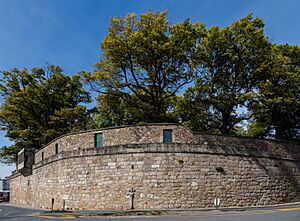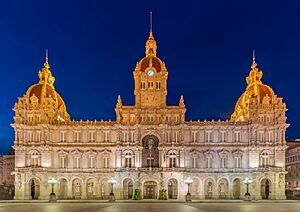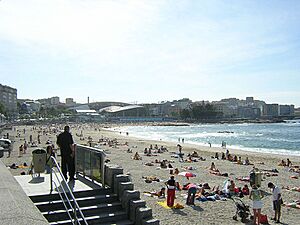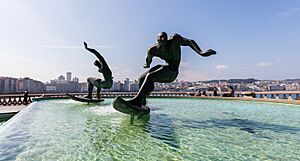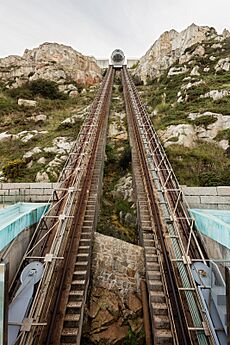A Coruña facts for kids
Quick facts for kids
A Coruña
|
|||
|---|---|---|---|
| A Coruña | |||
|
|
|||
|
|||
| Nickname(s):
A Cidade de Cristal (The Glass City)
|
|||
| Motto(s):
A Coruña, a cidade onde ninguén é forasteiro
(A Coruña, the city where nobody is an outsider) |
|||
| Country | |||
| Autonomous community |
|||
| Province | A Coruña | ||
| Comarca | A Coruña | ||
| Parishes | A Coruña, Elviña, Oza, San Cristovo das Viñas, Visma | ||
| Government | |||
| • Type | Ayuntamiento | ||
| • Body | Concello da Coruña | ||
| Area | |||
| • Municipality | 37.83 km2 (14.61 sq mi) | ||
| Population
(2024)
|
|||
| • Municipality | 249.964 | ||
| • Density | 6,613/km2 (17,130/sq mi) | ||
| • Metro | 431,332 | ||
| Demonyms | corunnan (en) coruñés, coruñesa (gl / es) |
||
| GDP | |||
| • Metro | €25.231 billion (2020) | ||
| Time zone | CET (GMT +1) | ||
| • Summer (DST) | CEST (GMT +2) | ||
| Postcode |
15001-15011
|
||
| Area codes | +34 981 and +34 881 | ||
A Coruña is a city and a municipality (a type of local government area) in Galicia, Spain. It's the second largest city in Galicia, after Vigo. A Coruña is the capital city of the province of A Coruña. It was also the political capital of the Kingdom of Galicia for many years.
The city is built on a promontory (a piece of land sticking out into the sea) in the Golfo Ártabro. This is a large bay on the Atlantic Ocean. A Coruña is a major industrial and financial hub in northern Galicia. It is also home to the Universidade da Coruña (University of A Coruña). A Coruña has the tallest average building height in Spain. It also has a lot of people living close together in its built-up areas.
Contents
About the Name of A Coruña
Where the Name Comes From
Nobody is completely sure where the name A Coruña comes from. It might come from an old word, Crunia, which was first written down a long time ago. The word "A" is like "the" in English.
One idea is that Crunia comes from a town in France called Cluny. Another idea, which seems more likely, is that the name simply means "The Crown." In Galician, this is A Coroa.
There's also a legend that says the name comes from the Greek word for "Crown." This story says that the hero Hercules killed a giant named Geryon. Hercules then buried Geryon's head and built a lighthouse on top of it. This lighthouse was built to honor Hercules. The city's coat-of-arms even shows a lighthouse on top of a skull and crossbones. This represents the buried head of Geryon.
How the Name is Used Today
In English, people often use the Spanish or Galician names for the city now. However, the old English name Corunna is still used sometimes. This is especially true when talking about the Battle of Corunna in 1809. Long ago, English speakers also called the city "The Groyne."
In Spain, the official name is "A Coruña" (Galician). But some people still use "La Coruña" (Spanish). However, "A Coruña" is becoming more common.
Geography of A Coruña
A Coruña is on a peninsula, which is land surrounded by water on three sides. Long ago, the land connecting it to the mainland was very thin, like a small strip of sand. Over time, more sand built up, making it wider.
Climate and Weather
A Coruña has a mild climate, which means the weather is usually not too hot or too cold. It's like a warm-summer Mediterranean climate. Autumns are usually mild, like spring. Winters can be windy and rainy because of storms from the Atlantic Ocean.
The ocean helps keep temperatures steady all year. There's only a small difference between winter and summer temperatures. Because of this, it almost never freezes or snows. The last time there was a lot of snow was in January 1987.
Springs are usually warm and calm. Summers are mostly sunny and humid. It might rain sometimes, but usually just light drizzle. High temperatures in summer are warm but rarely uncomfortably hot. This is because the sea keeps things cool during the day. Summer temperatures are usually around 22°C (72°F). It's rare for temperatures to go above 30°C (86°F).
City Areas
A Coruña is divided into five main areas called parishes. These are A Coruña, San Vicente de Elviña, Santa María de Oza, San Cristóbal das Viñas, and San Pedro de Visma.
The city also has many districts, each with its own unique feel. Some of these include the Old Town, Riazor, and Monte Alto.
History of A Coruña

Early Times
A Coruña started on a peninsula where the Tower of Hercules stands today. The oldest part of the city, called the Old City, was built on an ancient Celtic settlement. It's believed that Celtic tribes lived here a very long time ago.
Roman Era
The Romans arrived in the area in the 2nd century BCE. They saw how good the city's location was for trade. Soon, A Coruña became an important port for trading metals. In 62 BCE, Julius Caesar visited the city, then called Brigantium. He helped set up trade with places like France, England, and Portugal. The city grew, especially in the 1st and 2nd centuries, when the Tower of Hercules lighthouse was built. But after the 4th century, the city declined, especially when Vikings attacked. People had to move inland for safety.
Middle Ages
After the Roman Empire fell, A Coruña still had a port for trade. But it became a small village of workers and sailors.
In the 9th century, Vikings attacked the city many times. In 991, King Vermudo II started building defenses along the coast. A fortress was built in the ruins of the Tower of Hercules. To pay for it, the king gave control of the city to the bishop of Santiago. The bishop became very powerful in Galicia.
In 1208, King Alfonso IX officially re-founded the city of Crunia. He gave the city special rights, like being able to sell salt without paying taxes. This helped the city's fishing and trade businesses grow a lot. The city expanded across the thin strip of land connecting it to the mainland. In 1446, A Coruña was given the title of "City." It also became the main place for the Royal Audience of Galicia and the headquarters for the military.
Before 1492, a strong Jewish community lived in A Coruña. They created beautiful art, like the Kennicott Bible in 1476. This Bible is now in a famous library in Oxford, England. There's a street in A Coruña called "Synagogue Street," where their synagogue might have been.
Modern Times
In the modern period, A Coruña was an important port and textile manufacturing center. In 1520, King Charles I of Spain sailed from A Coruña to become the Emperor of the Holy Roman Empire. The city was also allowed to trade spices and goods with the Indies (the Americas). The San Antón Castle was built to protect the city and its harbor.
In 1589, the English fleet, led by Francis Drake, attacked A Coruña. But the English were defeated. This led to the legend of María Pita, a brave woman who helped defend the city. She grabbed her dead husband's spear, killed an English flag bearer, and encouraged everyone to fight back.
19th Century Changes
On January 16, 1809, A Coruña was the site of the Battle of Corunna during the Peninsular War. British soldiers fought against the French to help their troops get on ships and leave. The British general, Sir John Moore, was killed in this battle. A Coruña was the only city in Galicia that successfully fought off the French troops.
During the 19th century, A Coruña was a center for people who wanted to change the government. The city supported liberal ideas in many rebellions. It also played a big part in the Rexurdimento, a movement to bring back the Galician language and culture.
Economically, a cigarette factory opened in 1804. Other businesses like glass, foundries, and textiles also started. Trade by sea and people traveling to other countries brought money and investments to the city.
20th and 21st Centuries
At the start of the 20th century, A Coruña had about 45,000 people. The Great Depression and the Spanish Civil War hurt the economy. But in the 1960s and 1970s, the city's economy grew a lot. Many people from rural areas moved to A Coruña, and new neighborhoods quickly developed.
From 1983 to 2006, Francisco Vázquez Vázquez was the mayor. During his time, the city focused on services. He also oversaw the building of the Maritime Promenade and the city's Scientific Museums. These include the Casa das Ciencias (House of Sciences), Casa dos Peixes (Aquarium), and Casa do Home (House of Man).
In 2015, Xulio Ferreiro became mayor. He focused on improving city planning and fighting corruption. The current mayor is Inés Rey.
Population of A Coruña
Past and Present Population
| Historical population | ||
|---|---|---|
| Year | Pop. | ±% |
| 1842 | 19,415 | — |
| 1857 | 27,354 | +40.9% |
| 1860 | 30,132 | +10.2% |
| 1877 | 35,718 | +18.5% |
| 1887 | 39,609 | +10.9% |
| 1897 | 38,927 | −1.7% |
| 1900 | 44,057 | +13.2% |
| 1910 | 49,290 | +11.9% |
| 1920 | 63,603 | +29.0% |
| 1930 | 71,511 | +12.4% |
| 1940 | 98,834 | +38.2% |
| 1950 | 127,618 | +29.1% |
| 1960 | 173,661 | +36.1% |
| 1970 | 189,467 | +9.1% |
| 1981 | 231,721 | +22.3% |
| 1991 | 246,953 | +6.6% |
| 2001 | 236,379 | −4.3% |
| 2011 | 245,053 | +3.7% |
| 2021 | 245,541 | +0.2% |
| Source: National Statistics Institute | ||
After the War of Independence (1808–1814), the nearby city of Ferrol saw its population drop. But A Coruña's population grew a lot, especially after the Spanish Civil War in the mid-20th century. This growth continued, and A Coruña became one of the biggest cities in Galicia.
Today, the city of A Coruña has about 247,604 people. This means there are about 6,700 people living in each square kilometer.
In 2010, about 5% of the people living in A Coruña were from other countries. Most of these were from Brazil, Colombia, and Peru. When it comes to languages, about 7.75% of people speak Galician as their main language. About 36% speak Spanish, and the rest use both languages.
The larger area around A Coruña, called the metropolitan area, has about 431,332 people.
Main Sights to See
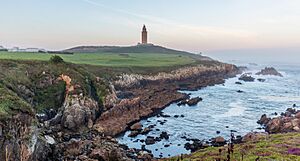
The city is home to the Roman Tower of Hercules. This lighthouse has been working continuously since possibly the 2nd century AD. It is a UNESCO World Heritage Site. Around the lighthouse is a large public park with a golf course. The lighthouse is the main symbol on the city's flag and coat of arms.
A Coruña is also known for its special glass balconies, called galerías. These balconies were first designed for ships to protect against bad weather. Then, people started adding them to houses in port cities.
The Old Town (Cidade Vella) is the oldest part of A Coruña. People moved here after Viking attacks. In 1208, King Alfonso IX re-founded the city here. You can still see parts of the old city walls and the Old Fortress. The Old Fortress is now the Garden of San Carlos, where Sir John Moore is buried. The Old Town has historic streets, squares, and old noble houses. The Royal Galician Academy, which studies Galician culture, is also here. There are also old churches like Santiago and Saint Mary. In July, a Medieval Fair is held in the Old City streets.
The city has several museums. These include the Castle of San Antón Archaeological Museum and the Fine Arts Museum. There's also a network of science museums: the Casa das Ciencias (House of Sciences) with a planetarium, the DOMUS (House of Man), and the Aquarium Finisterrae. In 2012, the National Museum of Science and Technology (MUNCYT) opened a branch in A Coruña.
Squares, Parks, and Beaches
- María Pita Square is the most important square in the city. You can see the City Hall here and a statue of the local heroine Maria Pita.
- Mount of San Pedro Park is a former military area. It offers great views of the city and the bay. You can get there by road or by a special elevator from the promenade. It has a cafe, play areas, and gardens.
- The Promenade (Paseo Marítimo) is about 9 kilometers (5.6 miles) long. It's one of the longest in Europe. It goes around the city's headland, passing sights like the Aquarium and the Tower of Hercules.
- In summer, the Orzán and Riazor beaches are very popular. They are right in the city center, across from the port. These beaches are great for tourists and surfers. During the María Pita festival in August, Riazor beach hosts a free music festival called Noroeste Pop Rock. Other smaller beaches in the city include As Lapas, O Matadoiro, San Amaro, and Oza. All these beaches have a "blue flag" certification, meaning they are clean and safe.
Economy of A Coruña
A Coruña is now the richest area in Galicia and a major economic driver. The city's economy has changed a lot. It now focuses on finance, communication, sales, manufacturing, and technical services. This has made A Coruña the wealthiest metropolitan area in Galicia. The port handles a lot of fresh fish. It also deals with large amounts of crude oil and other goods, making up 75% of Galicia's port traffic.
In 1975, the clothing company Zara opened its first store in A Coruña. It has since become a huge international clothing chain. Inditex, the world's largest textile manufacturer, has its main office in the nearby town of Arteixo. A Coruña produces 30% of Galicia's total economic output.
Other important companies in the city include banks like Banco Pastor and Abanca. There's also the Hijos de Rivera Brewery, the Repsol refinery, and the newspaper La Voz de Galicia. A Coruña is also a big shopping center. El Corte Inglés, a major department store, has two locations here. One is in Marineda City, which is one of the biggest shopping centers in Europe. It has stores like IKEA and Decathlon, cinemas, and even an ice rink.
The city has worked hard to improve its access and infrastructure. This includes cultural, sports, and science facilities. After a big oil spill from the Aegean Sea ship, a lot of effort went into cleaning the coast and boosting tourism. This has made A Coruña an important center for administration, trade, port activities, culture, and tourism. The city also has a regional airport that serves over a million passengers each year.
Tourism in A Coruña
Tourism in A Coruña has grown a lot. The city now welcomes many cruise ships each year.
The two main beaches, Orzán and Riazor, are right in the city center. They are very popular with tourists and surfers.
A big holiday is the night of San Xoán (St John), celebrated on June 23. People light huge bonfires on the beaches and in neighborhoods. They jump over the fires to scare away bad spirits. It's a massive celebration that lasts until dawn.
In 2006, the number of tourists visiting A Coruña was twice the city's population. The city has many hotels, including five-star and four-star options. A Coruña also focuses on business tourism. It has a large Congress and Exhibition Centre called PALEXCO and a new trade fair center, EXPOCORUÑA.
The city is also on the English Way, which is a path for pilgrims walking the Camino de Santiago.
Education and Culture
A Coruña has many schools for all ages. There are 38 pre-school centers, 47 primary schools, 29 vocational schools, and 33 secondary schools.
For higher education, there's the University of A Coruña, which is a public university. There's also a branch of the UNED and CESUGA, a private university center.
The city has many libraries, including municipal libraries and a public library. The Archive of the Kingdom of Galicia, which holds important historical documents, is in the Old Town.
You can also learn different languages at the Escola Oficial de Idiomas. They offer classes in English, French, Galician, Italian, German, Portuguese, Arabic, Russian, Chinese, Japanese, and Spanish for foreigners.
A Coruña is home to the Orquesta Sinfónica de Galicia (Galicia Symphony Orchestra). The city has two main theaters, Teatro Colón and Teatro Rosalía, which host plays and concerts. The Coliseum is a large center for concerts and sports events. Famous artists like Shakira and Iron Maiden have performed there. It also serves as a bullring in summer and an ice rink in winter.
The city's main festival is the María Pita Festival, from late July to mid-September. It includes free concerts, a Medieval fair, and a comic fair. Another popular festival is St. John's Day on June 23, with bonfires on the beaches.
Transportation
A Coruña is connected to other cities by major roads. The Autovía A-6 highway goes to Madrid. The AP-9 is a toll motorway that links A Coruña with other major cities in Galicia and goes all the way to the Portuguese border.
Air Travel
A Coruña Airport, also called Alvedro Airport, is about 7 kilometers (4 miles) from the city center. It has flights mainly to Spanish cities. There are also regular flights to London and Lisbon, and in summer, to Amsterdam and Paris. In 2015, over 1 million passengers used the airport.
Train Travel
Trains leave from San Cristovo Station. The city is connected to Madrid and Vigo by high-speed rail since 2021. Regional trains connect A Coruña with other Galician cities like Santiago de Compostela and Lugo. Longer-distance trains go to Madrid, Barcelona, and the Basque Country. There is also a freight train station for the port.
Bus Travel
Regional and intercity buses leave from the Bus Station. A Coruña has good bus connections to its surrounding area and other towns in Galicia. You can also take buses to major Spanish cities like Madrid and Barcelona, and even to European cities like Geneva and Paris.
Local Public Transport
Local buses in A Coruña are run by Compañía de Tranvías de La Coruña. They have 24 bus lines. The city used to have trams, but they stopped running in 2011.
Sports in A Coruña

A Coruña has many sports facilities. The most important is the Riazor Sport Complex. This includes Estadio Riazor, which is the home stadium of the football team Deportivo de La Coruña. It also has the Palace of Sports, home to the roller hockey team HC Liceo A Coruña, and swimming pools.
Deportivo de La Coruña is a famous football club founded in 1906. They play in the second division of Spanish football. They have won the Spanish league title once, in the 1999–2000 season. They also won the Spanish Cup twice. The club's women's team also plays in Spain's top division.
The city's roller hockey team, HC Liceo, is one of the best in Spain. They even became Europe's Champions in 2011.
A Coruña also has a basketball team, Básquet Coruña, which plays in Spain's second division. There are also Gaelic football teams that play in regional leagues.
The Casas Novas riding club, just outside the city, hosts many national and international horse riding championships.
Famous People from A Coruña
- Maria Pita (1565–1643), a heroine who defended A Coruña in 1589.
- Emilia Pardo Bazán (1851–1921), a famous novelist and journalist.
- Pablo Picasso (1881–1973), a world-famous artist, lived here for four years when he was young.
- Salvador de Madariaga y Rojo (1896–1978), a writer and poet.
- Fernando Casado Arambillet (1917–1994), a well-known actor.
- María Casares (1922–1996), a famous actress.
- Luis Suárez Miramontes (born 1935), a football player and manager.
- Amancio Ortega (born 1936), the founder of the fashion brand Zara (clothing).
- Nadia Calviño (born 1968), a politician who was the Minister of Economy.
- Mario Casas (born 1986), an actor.
- Lucas Pérez (born 1988), a football player for Deportivo de La Coruña.
International Connections
Sister Cities
A Coruña is connected with these cities around the world:
 Brest, France
Brest, France Cádiz, Spain
Cádiz, Spain Caracas, Venezuela
Caracas, Venezuela Mar del Plata, Argentina
Mar del Plata, Argentina Mariglianella, Italy
Mariglianella, Italy Limerick, Ireland
Limerick, Ireland Recife, Brazil
Recife, Brazil
See also
 In Spanish: La Coruña para niños
In Spanish: La Coruña para niños






